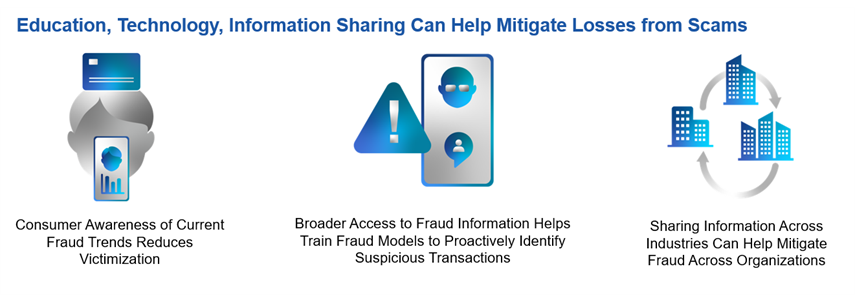Scams targeting consumers and businesses have become increasingly prevalent in recent years. There’s also been a groundswell of attention to the problem. However, the clear consensus among government entities, financial institutions, technology providers and other organizations is that we can do much more to address scams.
Approaches to putting scams out of business can fit into three categories: education, technology and information sharing.

Education
Awareness is a vital component of scam prevention. Unfortunately, individuals may not seek out information and resources until they have been burned – which sometimes means that they and/or their employers have lost significant money to a fraudster. So, proactive education is crucial.
Organizations have significantly reduced losses caused by scams by expanding their customer education, which may include information on fraud trends and guidance for customers after they have been victimized. In addition, an increasing number of companies conduct regular fraud prevention training for their employees across the enterprise. Security awareness training products and services are expected to be a $10 billion market by 2027 (Off-site), up from just $1 billion in 2014 (Off-site). Furthermore, financial institutions pay extra attention to training their front-line employees about scam warning signs to help them safeguard customers from suspicious transactions.
Consumer and business audiences also need to know what to do if they have been scammed. Quick action can be important. If a consumer is on the phone with a potential fraudster and is asked for a second credit card “because the first one didn’t go through,” hang up, call the company and ask them to both cancel your card and reverse any suspected fraudulent transactions. It’s also important to report the scam to help protect others from falling victim to the same scheme. Visit USA.gov (Off-site) for fraud reporting information and links to organizations that track scams and fraud.
Technology
An increasing number of service providers offer technologies that help prevent scam losses. For example, these technologies can identify a payment related to a scam before the funds leave the financial institution; use internal and external data to proactively identify potential fraudsters, such as money mules (someone who transfers illegally acquired money on behalf of someone else); and generate customer alerts to flag suspicious activity.
 Insights from current and emerging scams can improve the performance of fraud management models by training them to identify payments associated with scams. Given the sheer volume of scams and fraud these days, fraud management models increasingly incorporate machine learning. This method of data analysis identifies patterns and generates decisions based on data and statistical models “trained” on large amounts of data. It does not rely on pre-defined fraud detection rules and therefore, is often more effective than static fraud detection approaches, which require more time to identify trends and implement changes.
Insights from current and emerging scams can improve the performance of fraud management models by training them to identify payments associated with scams. Given the sheer volume of scams and fraud these days, fraud management models increasingly incorporate machine learning. This method of data analysis identifies patterns and generates decisions based on data and statistical models “trained” on large amounts of data. It does not rely on pre-defined fraud detection rules and therefore, is often more effective than static fraud detection approaches, which require more time to identify trends and implement changes.
Information Sharing
 Sharing of aggregate, anonymized fraud information between organizations is emerging as a key factor to help prevent fraud and avoid potentially devastating losses from scams. Fraud management models armed with shared information facilitate quicker identification of trends, because fraud schemes generally are used across multiple organizations and industries. Incorporating larger data sets into fraud models also generally improves predictive performance, helping organizations develop more timely and better-informed fraud management strategies.
Sharing of aggregate, anonymized fraud information between organizations is emerging as a key factor to help prevent fraud and avoid potentially devastating losses from scams. Fraud management models armed with shared information facilitate quicker identification of trends, because fraud schemes generally are used across multiple organizations and industries. Incorporating larger data sets into fraud models also generally improves predictive performance, helping organizations develop more timely and better-informed fraud management strategies.
In addition, shared fraud information can help participating financial institutions better distinguish fraud from normal payment activities, reducing friction that can discourage customers from making a legitimate transaction or purchase. Beyond scam prevention, information sharing is especially helpful in preventing fraud at account opening, addressing authorized push payment fraud, authenticating identities, validating accounts before a transaction is processed, and monitoring both payment transaction flow and approvals.
What’s Next?
In 2023, the Federal Reserve is continuing efforts to improve understanding of scam trends, mitigation strategies and gaps, education campaigns and opportunities for information sharing. In addition, the Fed will convene industry work groups to develop a common definition and taxonomy of scams and promote information sharing, with the goal to better help identify, accurately report and ultimately, address this type of fraud. Watch for additional information on this and other collaborative efforts to improve payments security.